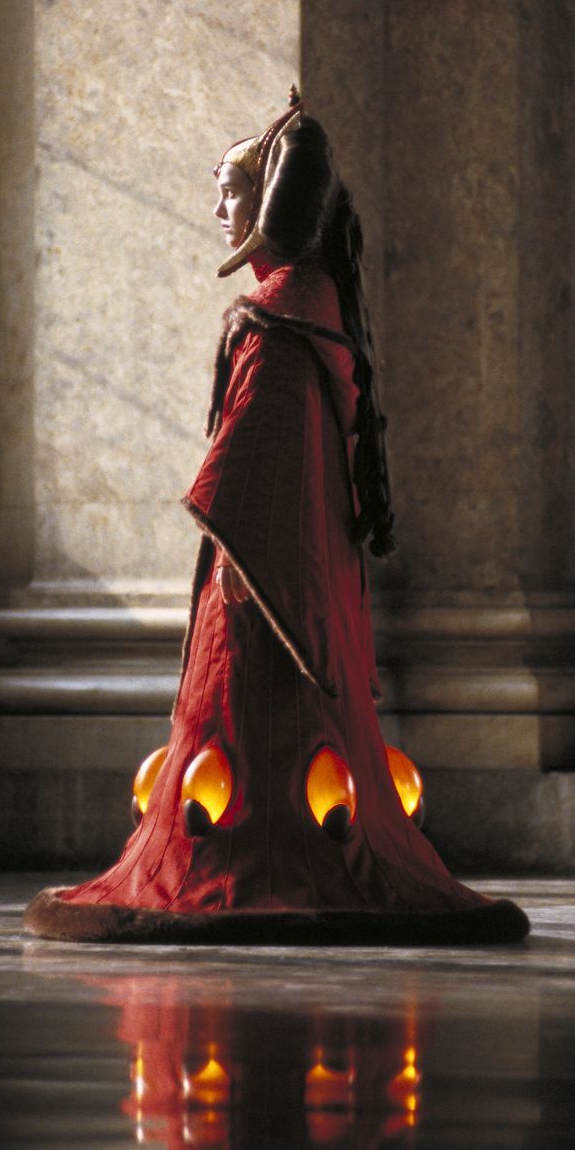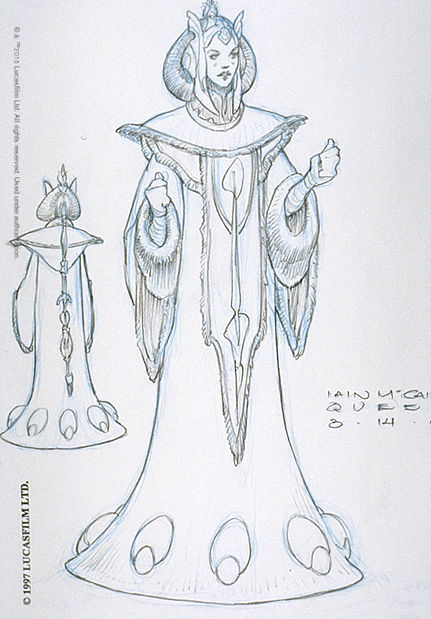The throne room gown was worn by Queen Padmé Amidala of Naboo in her throne room at Theed Royal Palace and for royal functions. The attire was one of her most lavish and impressive, intended to delight visiting dignitaries while conveying the hope and dignity of the Naboo. The red silk gown had gold embroidered motifs on an elaborate tabard covering her shoulders and chest, with a black trim made with fur shed by creatures called potolli. The wide skirt was decorated with self-illuminating yellow and orange sein jewels that glowed from within.
When Amidala was dressed as the Queen and not her private identity, her hair was tightly braided and pinned on top of her head, then the pins were gelled to prevent itching and help hold in place a wig matching her natural hair color. The headdress for her throne room gown had hair sculpted over a padded frame in a wide arch around her face, paired with the Jewel of Zenda on her forehead and gold faceframes lined with red. Further tresses of hair ran down her back to her waist, and her fingernails were painted white. Her traditional royal makeup included white foundation, red dots on both cheeks beneath her eyes, and a scar of remembrance; a red stripe was painted on her lower lip to symbolize the suffering endured by the Naboo before the Great Time of Peace.

Self-illuminating sein jewels glow from within.
In 32 BBY, Padmé Naberrie was elected and began her royal wardrobe as Queen Amidala. The throne room gown originally fitted the hem to a circular frame and was worn with an underdress to support its weight. Amidala wore it as she said farewell to dignataries who attended the Chommell sector summit she had held to promote cooperation between planets in the Chommell sector. As they departed, Amidala saw something in the sky and overheard troubling comlink chatter; the Trade Federation had begun their planetary invasion. The luminescent sein jewels would make her visible to a ship, but she had difficulty moving quickly in the gown to get indoors.
Afterward, her handmaiden Yané revised the gown to support its own weight, making the ensemble lighter and easier to move in; it thus became Amidala's most wearable attire that was still suitably regal. She wore it again when she spoke to the Trade Federation Viceroy Nute Gunray and the Naboo Royal Advisory Council during the invasion.
Following her death, Amidala was often depicted wearing the gown. During the Imperial Era, at least one mural was in the city of Theed; when it was seen by her daughter, Leia Organa, Organa had the impression of the figure moving to look at her. The royal palace also had stained glass windows depicting Amidala in the gown. In death, her tomb was guarded by a monumental statue depicting her wearing the gown. There was also a statue of Amidala wearing the gown in the gardens in the Royal Palace of Alderaan.

Iain McCaig's concept art
Padmé Amidala's throne room gown was created for the 1999 prequel trilogy film, Star Wars: Episode I The Phantom Menace. Artist Iain McCaig conceptualized the design in 1997, and the finished costume was realized by costume designer Trisha Biggar and the costume department. The film's marketing featured the costume.
McCaig said that when he was designing the costume's concept and incorporated lanterns in the hem, George Lucas rolled his eyes and told him to create schematics of how that would work; McCaig succeeded and Lucas approved the concept. Biggar described the cultural and historical basis of the design as a "Chinese Imperial feel."
Biggar considered the costume one of the most complex and difficult to realize. Nearly eight weeks of work began with designing an undergarment to help ensure a perfect fit for actress Natalie Portman. The undergarment's shape, which Biggar likened to an upside-down ice cream cone, was constructed with multiple canvas panels reinforced by crinoline steel rings around the hem to maintain a rigid shape and support the weight of the gown's fabric. The rings and multiple layers of fabric were also needed to support the lights and the wires that were connected to batteries to power them. Maintaining the hem's shape allowed it to skim along the floor as if Amidala was floating or gliding; however, Biggar noted that Amidala's costumes were a challenge to walk in. The lights themselves were contained in vac-formed Perspex with a color wash of French enamel varnish.
While Biggar originally considered velvet for the dress, film lighting would have made obvious the reversal of the velvet pile in the sections cut on the cross, so she switched to silk-satin cord mounted on densely-woven silk. Each panel was self-piped, and there were approximately twenty-five panels in the dress and fifteen in each sleeve. Faux fur was used for the edges and lining of the collar, sleeves, and the hanging center-front piece, which had gold buillion embroidery.
- LEGO Star Wars: Droid Tales — "Exit from Endor"
- LEGO Star Wars: The Freemaker Adventures — "The Kyber Saber Crystal Chase"
- Star Wars Character Encyclopedia: Updated and Expanded
- Star Wars Propaganda: A History of Persuasive Art in the Galaxy
- Star Wars: The Visual Encyclopedia
- Star Wars: The Complete Visual Dictionary, New Edition
- The Star Wars Archives: Episodes I–III, 1999–2005
- Star Wars: The Secrets of the Sith
- Star Wars: Timelines